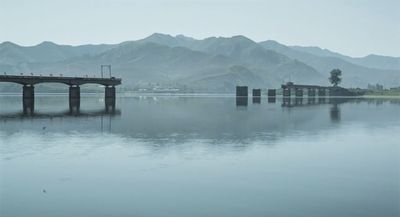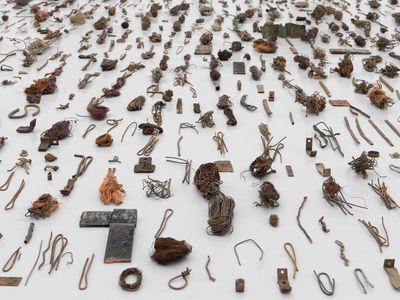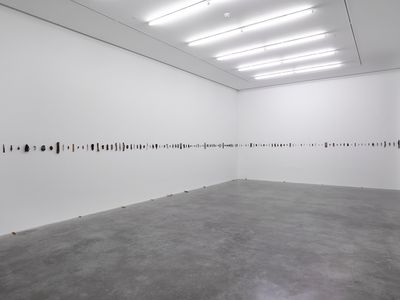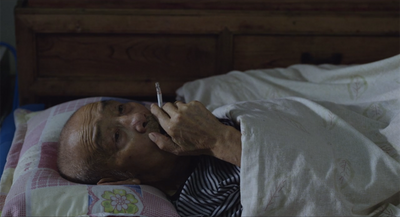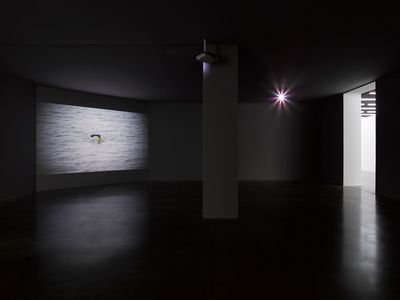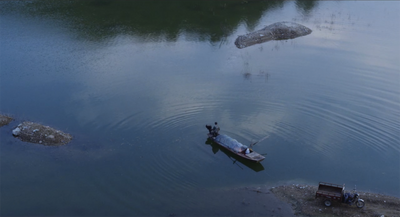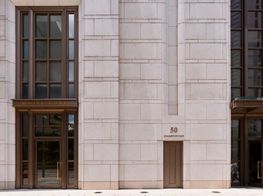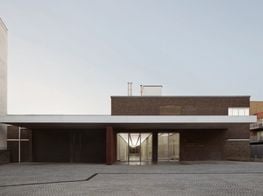He Xiangyu
He Xiangyu. Courtesy White Cube. © He Xiangyu Studio.
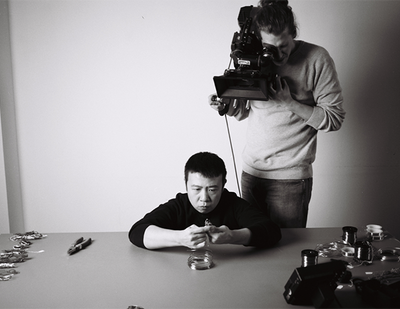
He Xiangyu. Courtesy White Cube. © He Xiangyu Studio.
He Xiangyu's second solo exhibition, Evidence, at White Cube gallery's Bermondsey space in London (7 February–8 April 2018) is somewhat different from the artist's first exhibition with the gallery in 2014 (He Xiangyu: Inside the White Cube, 22 January–13 April 2014). Gone is the crystallised residue of 127 tonnes of Coca-Cola that the artist boiled in one year with the help of migrant workers (Coca-Cola Project, 2009-2012); and the deflated life-size military tank made out of luxury Italian leather by factory women (Tank Project, 2011-2013). There is no 200-gram gold egg carton (200g Gold, 62g Protein, 2012); nor is the miniature Chinese pagoda partly made out of the artist's wisdom teeth on view (Wisdom Tower, 2013).
In general, He Xiangyu's practice is defined by 'projects'—works grouped together based on their specific subject matter. In the case of Lemon Project, for instance, the study of lemons manifested into a series of sculptures, paintings, videos and installations. His latest White Cube show is no different. Unexpected and ambitious, it showcases a feature-length documentary, a video work, and numerous found and handmade objects that deal comprehensively with the artist's experience of revisiting his hometown Kuandian in northeast China, and the encounters he had with the people there.
Kuandian comprises just over 6,000 square kilometres, and has a population of some 430,000 people. Separating the small and underdeveloped county from North Korea is the Yalu River—a natural border that was of strategic importance in a number of wars throughout history, including the First Sino-Japanese War (1894-1895), the Russo-Japanese War (1904-1905), the Second World War, and the Korean War (1950-1953). Because of its special geographical position, Kuandian receives many defectors from North Korea, who risk their lives by swimming over to the area, which is also home to many Chinese veterans, now dead or dying, who fought in the Korean War.
He Xiangyu, along with a sizeable film crew, interviewed a number of defectors and veterans over the course of two years, exploring their personal histories and Kuandian's complex geopolitical significance. This resulted in a feature-length documentary, The Swim (2017), which was first premiered at the Solomon R. Guggenheim Museum in New York in February 2017 and is now being screened as part of his White Cube exhibition. During the making of this documentary, he learned how defectors would scavenge metal objects of minimal value before they fled North Korea, carefully folding them into smaller sizes and smuggling them in their clothes into China. He collected a number of these objects, which could be described as meticulously sculpted, and created a series of small sculptures based on them—the former hang at eye level in the White Cube show, the latter are laid on the ground. The process of recreating these scavenged items is documented in the video Evidence (2017), also on view in the exhibition, which the artist discusses in this conversation.
APNow that it has opened, how do you feel about your latest exhibition at White Cube?
HXWhen it comes to exhibitions, large or small, I always have a rather strange feeling during the installation process and before the openings. Even after the exhibition opens, I always have this inexplicable, unreal feeling. Since the completion of Coca-Cola Project in 2012, I have been working as an artist and exhibiting for six years, and I have consistently had this feeling throughout that time. I still feel rather unreal today.
APYou worked for two years in total for this exhibition, is that correct? That includes the time you spent filming the documentary.
HXMore or less. The gallery and I had to decide at the beginning of 2017 between continuing the Lemon Project started in 2014, and the Evidence project that you see now. After numerous discussions, we eventually decided to go with the latter. I was not so sure about the project at first. I have been collecting the copper objects you see in the exhibition for a long time. These objects are powerful, because the textures, content, information or the stories behind them are all immensely rich and complex. Therefore, I found it difficult to transform these objects in my own way. I thought that working on the objects meant consuming or exploiting them, and felt uneasy when thinking about approaching them.
API understand that you bought these metallic objects displayed throughout the gallery from the black market?
HXYes. Precisely speaking, I bought them from a family that lives somewhere between Dandong and Kuandian. The family regularly buy these objects from North Koreans and often sells them to local scavengers. I came across the trade by chance.
Only after a long time did I decide on the format for presenting these copper objects in the exhibition. That is, to imitate with my own hands how they were handled in the first place by the defectors, and recount the story of the origin of these objects. People look for and indeed find metals of value and claim them as their own. Imagine that important moment when they first lay their hands on the metals they find, then folding and making these materials as small and as portable as possible, hiding them in their clothes and bringing them on their trip to China. In this exhibition, I try to relive that experience.
APIn the exhibition, the documentary The Swim and the video piece Evidence correspond brilliantly to the objects, and in particular those that you created in response to them, as they also involve a process of reproduction.
In The Swim, you relive the defectors' experience of swimming from North Korea to China by doing it yourself. My first impression of the film was that it clearly represents two parties: those people with faces, and those without faces. Those without faces—that is, those whose faces are covered or blurred in the post-production phase of the film—seem to live tragically. On the other hand, those with faces—Chinese veterans who fought in the Korean War, and most significantly, you, the artist—seem nothing less than heroic.
Is it your intention to create this 'economy of faces'? If so, to what extent is it meaningful?
HXThe video work that I most wanted to bring people's attention to is Evidence, which records my reenactment of the defector's sculpture-making process. I think it is crucial to understanding the whole narrative.
In the films, I had to be visible from time to time; but I do not agree that those with faces are rendered as heroic in the film. The defectors do not mind exposure, but for ethical reasons I decided that their faces should be blurred; it makes it safer for them.
In fact, many of the defectors live better lives than the Chinese veterans. As shown in the film, a number of North Korean women were tricked into coming to China. After they arrived, they had to marry Chinese men and form a family—they were basically sold as wives from North Korea. But the families they married into are comparatively well off. To live a better life is basically the defectors' most important, if not the only, motive. True, many other defectors live under harsh conditions, such as the woman in the film who reports that she has been subject to constant domestic violence, and of course defecting from your own country and blending into a new environment is a very traumatic experience. But in terms of living conditions, most defectors are doing better in their new families.
APDo you agree that The Swim and other works in the project seem to have a unique sociological aspect that distinguishes this from your other long-term projects? In most of your other works, the social or sociological seem to be of secondary importance.
HXFirst, it is difficult for me to make this judgement myself. Secondly, I think other projects of mine, such as Coca-Cola Project, are very rich in terms of their social or sociological significance. The definition of a specific genre of sociological art is also very vague, in my opinion. I think some artworks are more abstract in terms of their social or sociological significance, and others are more specific and detailed.
In October 2018 I plan to publish a book about the Lemon Project, which will discuss the anthropological, sociological, natural history and political significance of a project that does not explore a localised problem in detail. In a fairly abstract way, it deals with general problems and questions. The texture and warmth, for example, of the works in the Lemon Project are of strong social significance. I do not think the works in Evidence are very different on this level.
APHow do you treat the differences between your projects in terms of subject matter and methods?
HXJust like other works of mine, the exhibition takes the body as its point of departure. For Coca-Cola Project, I started by cooking Cola. For Palate Project (2011-2016), I started with an important part of my body—my mouth. I once took the door to my apartment down, made it into an artwork, and lived in an open apartment for two months. With regards to May 14th, July 17th, August 27th (2016), shown in Beijing in 2017, and The Yellow Swim Caps (2016), that I recently made along with The Swim—the connections between those works are very strong to me.
APWould you say that, traditionally speaking, using the body as a point of departure is feminist in nature?
HXI do not think men and women are very different when it comes to artistic creation. As a man, Van Gogh cut his ear off, which was very bodily. I was born in Kuandian in northeast China, went to school in Donggang, lived in Shenyang and Beijing, then Pittsburgh and New York, and now I am based in Berlin. I realise that the only medium that is not going anywhere and is always at hand is my own body. I am also aware that my consciousness, or the mastering of my body, is only a small part of the process. Coca-Cola Project started with a bodily experience, but over the years the development of the long-term project goes far beyond that.
For me, this process means acknowledging and coming to terms with my own defects and deficiencies, in terms of my linguistic ability and the fact that I have been in a spiritual or cultural diasporic state for so long. In the past, I tried looking the other way, deliberately overlooking these factors; but these defects and deficiencies have come back in a compressed form and have re-emerged in my work. A return, as such, is very powerful.
APYou are an artist from China but are now based in Berlin and married to a South Korean woman, and you just opened your second show at White Cube in London. Is your racial or cultural identity a topicalised subject for you?
HXMy wife was born in South Korea and grew up in the States, so she is actually more American than Korean. Identity awareness was present and strong when I first went to the States, where I realised very clearly that I was Chinese born in northeast China and raised in Beijing. Back then, I thought it was very important, and the shock was strong. Since coming to Europe it has become much less significant.
I think many things we do or think about today go way back to our childhood. Through childhood, people's experiences transform in various ways. After living in Berlin for four years, I realised that the contemporary conditions of the city in fact consist of two distinct parts—East and West Berlin—that are still very present ideologically. Infrastructures and facilities all come in pairs, which are different in terms of aesthetics, style and underlying ideologies. This impression in turn changes my understanding of my hometown. In this sense, making The Swim, a work about my hometown, was a natural move.
APThe 20-minute video work The Yellow Swim Caps (2016) is not on view in the exhibition, but is also relevant to the subject of the show. It is a straightforward recording of the swim you made from China to North Korea in full. Unlike The Swim, the work seems humorous in nature, as it skirts the historical and social contexts of the act. Is it your intention to establish a balance between seriousness and humour in The Swim and The Yellow Swim Caps?
HXI prefer developments that are natural and organic to forced atmospheres and emotions. It was intolerably cold, so my whole body ached terribly when I hit the North Korean shore, and my body eventually became numb. However, when I was editing the film and going through the footage I realised that I was smiling when I reached land, totally unconsciously. Although it was totally unconscious, I thought it was a very natural thing.
APThe Swim is your first feature-length documentary film. Are you interested in making more in the future?
HXI am conflicted. The shooting of the film was very interesting, but since it involves a large number of people it poses difficulties and problems. It has to be a large-scale, complex operation. With the right ideas and sufficient preparation, I would like to do it again.
APYou have created a number of video works in recent years, including the ambitious Turtle, Lion and Bear (2015), a large-scale, elaborate video installation depicting in slow motion the act of yawning across species; July 16th (2016) and May 14th (2016), on view in your last solo exhibition at White Space Beijing in 2017, which speaks about collective and performative art-making processes and a certain notion of community and playfulness.
Coming from a background in painting, are there any video artists that you like in particular?
HXI created my first video work in 2012. It was a four-channel video work titled Shadow, which I shot on my phone. Turtle, Lion and Bear, which I showed at the Biennale de Lyon in 2015, was the first video work I did with professional cameras. I do not quite remember names, but I do enjoy a lot of video and film works by others. For instance, Bruce Nauman's Good Boy Bad Boy (1985) and Anri Sala's Uomoduomo (2000), Mixed Behaviour (2003) and Long Sorrow (2005). When I create video works, I solely work with my experiences of creating paintings and installations. That is why Turtle, Lion and Bear was shown in vitrines and used a lot of reflective effects.
APHow would you describe your painting process?
HXTake the Palate Project as an example. I try to work in a way that is, again, organic. It is difficult to capture or portray the interior of the mouth through techniques learned in art school. In art school you are taught to tell the abstract from the figurative, but the interior space of the mouth is something that is rather ambivalent. One cannot see the space, but one can always feel it. It is an experience that is extremely personal and individual. I have not painted for about two years, and I want to pick it up again.
APWhat is your long-term plan?
HXI constantly have to work on the move, so with this ever-changing environment I cannot make specific and detailed plans. I do think that my projects are tightly connected to one another. Even some of the rather unsubstantial and neglected works are neatly connected, such as Olive Oil–Past is Prologue (2014) and Straight Line 15-1 (2015). I have only been practising as an artist for about six years, and for an artist that is far from long enough.—[O]


